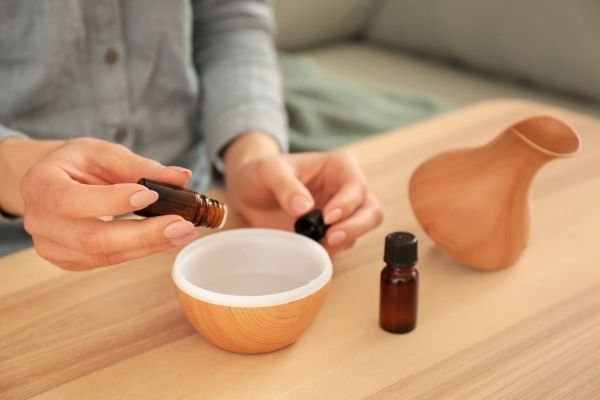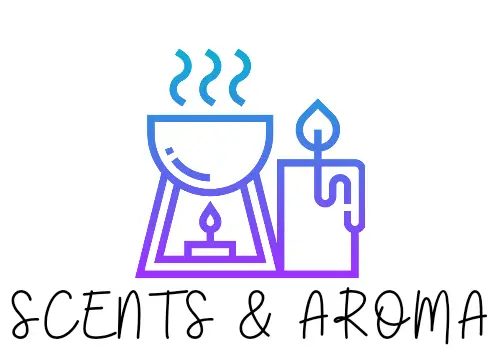The recommended drops for a 100ml diffuser are 3-5 drops. However, the number of essential oil drops will depend on other related factors like the size of the room, the user’s health condition, the quality of the oil, and the type of essential oil that is being used.
In this article we would be talking about the following:
- Can you put too much essential oil in your diffuser?
- What is the perfect amount of essential oil to put in the oil diffuser?
- What should you do if you put too much essential oil in the diffuser?
- What are the symptoms of essential oil overdose?

CAN YOU PUT TOO MUCH ESSENTIAL OIL IN YOUR DIFFUSER?
Yes, you can. Essential oils are concentrated chemical substances hence, they have strong scents. It is possible to put more essential oil than is considered healthy in your diffuser.
When this happens, the air becomes too concentrated for breathing, and your body will react differently to it; instead of being therapeutic, you might end up getting negative results. For this reason, there are a recommended number of drops to be used in the diffuser.
WHAT IS THE PERFECT AMOUNT OF ESSENTIAL OIL TO USE IN THE DIFFUSER?
This will differ depending on the type of diffuser used. Here are the number of essential oils to be used for some common diffusers:
- ULTRASONIC DIFFUSERS: These diffusers come in different sizes, from 100-500ml. The most common size is 100ml and 3-5 drops is the recommended number of drops to be used. Consequently, for the 500ml diffuser, 15-25 drops is recommended, 3-5 drops for each 100ml.
- REED DIFFUSERS: The reed diffusers use a mixture of essential oil and carrier oil. So, for the normal-sized reed diffuser, 25-30 drops of essential oil should be mixed with ¼ cup of carrier oil. If you are using water instead in your reed diffuser, 25 – 30 drops in ⅓ cup of water is the recommended amount because it evaporates faster. However the size of the jar, the mixture should be in a ratio of 85-15 percent. For a stronger scent, a ratio of 75-25 percent is appropriate.
- NEBULIZING DIFFUSER: The nebulizing diffuser doesn’t need any carrier to break down the oil. It uses pressurized air to break down the oil. For this type of diffuser, 20 – 25 drops is the recommended number of drops to be used.
- EVAPORATIVE OR HEAT DIFFUSERS: For the heat or evaporative oil diffuser, use one drop of essential oil for 10ml of carrier oil.
Actually, there is no perfect amount of essential oil to use in your diffuser. This is because, besides the recommended number of drops to be used, other factors could determine how many drops you should use.
OTHER FACTORS TO CONSIDER WHEN CHOOSING THE AMOUNT OF ESSENTIAL OIL TO USE
When you are going to decide on how much essential oil to put in your diffuser you may want to take some of these additional factors into consideration.
- ROOM SIZE: How big or small the room is will also influence the amount of essential oil to be diffused. If the room size is large, you might need to add a few more drops to get a reasonable scent. However, if the room is smaller, you might want to use 3 drops in your 100ml diffuser.
- HEALTH CONDITION: For people who have lung problems and allergies, it is best to use lesser quantities, maybe 1-2 drops in your 100ml diffuser. Seek your doctor’s advice to know what works for you.
- AGE: When diffusing essential oils around children, you might need to reduce the amount of oil to be used in the oil diffuser. Also, note that you shouldn’t diffuse essential oils around babies.
- THE TYPE OF ESSENTIAL OIL: Some essential oils do have stronger scents than others, and so, you might need to use lesser quantities. For those with milder scents, you might also need to add more drops to get your room scenting. Some essential oils with stronger smells are catnip, ylang-ylang, cassia, oakmoss, cinnamon and Nootka tree essential oil.
Some essential oils with milder scents are lavender, bergamot, and neroli essential oils.
If you are just starting out with using diffusers, start from smaller drops to figure out how much is enough for you. Also, some diffusers have instructions on how many drops to use. You might want to follow the manufacturer’s instructions first.
WHAT SHOULD YOU DO IF YOU PUT TOO MUCH ESSENTIAL OIL IN YOUR DIFFUSER?
Do not panic if you discover you used excessive drops of essential oil. Fixing this problem is quite simple.
Get an airtight jar and turn about half of the content of your diffuser into it. Cover it and keep it to use when you need to refill the diffuser. Dilute the one in your diffuser with either water or carrier oil, depending on the type of diffuser.
If it’s a diffuser that doesn’t use any essential oil carrier like carrier oil or water, just reduce the drops of essential oil to the recommended one.
WHAT ARE THE SYMPTOMS OF USING TOO MUCH ESSENTIAL OIL IN THE DIFFUSER?
Using too many drops of essential oils in your diffuser will cause health discomforts. Here are some likely symptoms of essential oil overdose:
- Headaches
- Migraines
- Nausea
- Itchy eyes
- Dizziness
- Sneezing
- Respiratory tract irritation
- Vomiting
- Skin irritation
If you notice any of these symptoms, you might consider reconsidering the amount of essential oil you use in your diffuser.
CONCLUSION
While good things have great benefits, too much of everything is harmful and this also applies to using essential oils. Aromatherapy is beneficial to the health but using essential oils should be done in moderation. Using more than is recommended could make you feel sick and will be disadvantageous to your health. While putting the recommended amount into consideration,also consider other factors that could determine how much essential oil to be used.
If you are still not certain about how many drops to use, especially if you have breathing problems, seek medical advice. Also, make sure you do not diffuse essential oils in a room that has poor ventilation as this will increase the effect of the essential oil being used.
- Can You Put Perfume In A Humidifier? (Read First) - September 17, 2022
- Can You Put Essential Oil In A Steam Mop? (Safety Advice) - September 17, 2022
- How To Make Lavender Oil At Home ( Candles And Diffusers) - September 9, 2022

